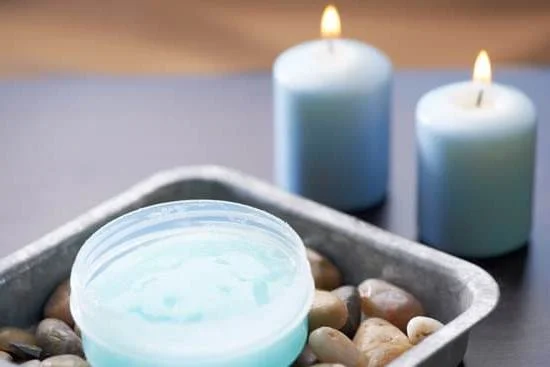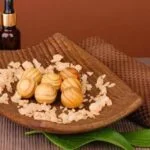Are crystals aromatherapy? The combination of these two alternative healing practices has gained popularity in recent years, sparking curiosity and debate about their effectiveness. Crystals are believed to have healing properties, while aromatherapy uses essential oils for therapeutic purposes. This article aims to explore the relationship between crystals and aromatherapy, shedding light on their history, scientific basis, and ethical considerations.
Crystals have been used for centuries in various cultures for their alleged healing abilities. These natural formations are thought to harness energy and promote physical, emotional, and spiritual well-being. On the other hand, aromatherapy involves the use of essential oils derived from plants to improve one’s health or mood. Both practices are rooted in alternative medicine and holistic healing approaches, garnering interest from individuals seeking natural remedies for their ailments.
In this article, we will delve into the science behind crystals and aromatherapy, examining the evidence (or lack thereof) supporting their use in healing. We will also explore the historical origins of these practices and how they have evolved over time.
Additionally, we will look at specific types of crystals commonly used in aromatherapy and compare the application and potential benefits of essential oils versus crystal healing. Furthermore, personal experiences with both practices will be shared, along with an examination of ethical considerations related to their sourcing and use.
As we embark on this exploration of crystals and aromatherapy, it is important to approach these topics with an open mind and a critical eye towards understanding their place in alternative medicine. Whether you are a skeptic or a believer in these holistic healing practices, this article aims to provide valuable insights into the question “Are Crystals Aromatherapy?”.
The Science Behind Crystals and Aromatherapy
When it comes to the scientific evidence supporting the use of crystals and aromatherapy for healing, the findings are often inconclusive. While some studies have suggested potential benefits, such as reducing stress and anxiety, many experts argue that these effects may be attributed to a placebo effect rather than the actual properties of crystals or essential oils.
The placebo effect refers to the phenomenon where a person experiences a perceived improvement in their condition simply because they believe in the treatment they are receiving.
The lack of concrete scientific evidence has led to skepticism surrounding the efficacy of crystals and aromatherapy in traditional medicine. Critics argue that without empirical data to support their claims, these practices should not be considered legitimate forms of treatment. However, proponents of crystals and aromatherapy point to the long history of their use in various cultures and traditions, suggesting that there may be subtle yet significant effects that science has yet to fully understand.
In exploring the placebo effect and its potential role in the perceived benefits of crystals and aromatherapy, it is important to consider the subjective nature of personal experiences with these practices. Anecdotes and testimonials from individuals who have used crystals and aromatherapy for healing play a crucial role in shaping beliefs around their effectiveness. This subjective element complicates attempts to measure the true impact of these practices objectively, making it challenging to draw definitive conclusions about their scientific validity.
History of Aromatherapy and Crystal Healing
The practices of aromatherapy and crystal healing have deep historical roots that stretch back to ancient civilizations. In the case of aromatherapy, it has been used for thousands of years in various cultures for both medicinal and spiritual purposes.
Ancient Egyptians, Greeks, and Chinese societies are known to have utilized aromatic plants and essential oils in their healing rituals and religious ceremonies. The use of scented oils for their therapeutic properties continued through the Middle Ages and into the Renaissance period, eventually paving the way for modern-day aromatherapy practices.
Similarly, the use of crystals for healing dates back thousands of years in numerous cultures around the world. Historically, crystals were believed to possess various metaphysical properties that could aid in physical, emotional, and spiritual well-being. Ancient civilizations such as the Egyptians, Aztecs, and Native American tribes used crystals in various forms for healing rituals and ceremonies. The belief in the power of crystals has persisted through different time periods and has influenced alternative medicine practices today.
Cultural and traditional uses of both aromatherapy and crystal healing have contributed to their evolution over time. As these practices spread across different regions and communities, they integrated with local customs and beliefs, adding layers of diversity to their applications.
Today, modern interpretations of aromatherapy and crystal healing encompass a wide range of cultural influences, making them versatile tools in alternative medicine. This historical context is important for understanding how these practices have developed alongside human civilization’s growing understanding of health and wellness.
Types of Crystals Used in Aromatherapy
Crystals have been used for various purposes, including healing, for centuries. In the context of aromatherapy, specific types of crystals are believed to enhance the therapeutic properties of essential oils and promote overall well-being. Some commonly used crystals in aromatherapy include amethyst, rose quartz, citrine, and clear quartz.
– *Amethyst*: This purple crystal is associated with relaxation and stress relief. When used in conjunction with aromatherapy, it is believed to promote calmness and mental clarity.
– *Rose Quartz*: Known as the “love stone,” rose quartz is often used to attract love and foster emotional healing. Paired with aromatherapy, it is thought to enhance feelings of compassion and self-love.
– *Citrine*: With its sunny yellow hue, citrine is associated with abundance and positive energy. In combination with essential oils, it may be utilized to promote optimism and vitality.
– *Clear Quartz*: Considered a master healer, clear quartz is said to amplify the effects of other crystals and essential oils. It is often used in conjunction with other crystals to intensify their healing properties.
The purported benefits of using these crystals in aromatherapy are based on the principle that each crystal emits its own unique energy frequency, which can interact with the body’s energy field. While scientific evidence supporting these claims is limited, many individuals continue to incorporate crystals into their holistic wellness routines as a complementary practice alongside aromatherapy.
Aromatherapy Essential Oils vs Crystal Healing
When comparing aromatherapy essential oils and crystal healing, it’s important to understand the distinct characteristics and potential benefits of each practice. Aromatherapy relies on the use of essential oils derived from plants, flowers, and herbs, which are then inhaled or applied to the skin for therapeutic purposes. These oils are believed to have various physical and psychological effects on the body, such as reducing stress, improving sleep, and alleviating pain.
On the other hand, crystal healing involves the use of specific gemstones or crystals to restore balance and promote well-being. Each type of crystal is thought to possess unique properties that can positively influence a person’s energy, emotions, or physical health. These crystals may be worn as jewelry, placed in living spaces, or used during meditation practices.
Differences between the two practices also extend to their application methods. Aromatherapy often involves diffusing essential oils into the air through a diffuser or diluting them with a carrier oil for topical use. In contrast, crystal healing may involve placing crystals directly on the body’s energy centers or using them as massage tools. Additionally, while aromatherapy is primarily olfactory-based (relating to sense of smell), crystal healing focuses on harnessing the vibrations and energies emanated by crystals themselves.
This distinction raises questions about how these practices could complement each other in holistic healing environments. Some practitioners may incorporate both aromatherapy essential oils and crystal healing techniques into their wellness routines to address multiple aspects of overall well-being. The possible synergistic effects of combining these modalities offer an intriguing area for further exploration within alternative medicine and holistic wellness approaches.
- Both practices focus on promoting overall well-being
- They differ in terms of materials used – essential oils vs gemstones/crystals
- Each has its own unique application method
Personal Experiences With Crystals and Aromatherapy
Subjective Healing
Many individuals who have experimented with crystals and aromatherapy have reported positive experiences with these practices. Whether it is the calming scent of lavender essential oil or the purported energy-balancing properties of amethyst crystals, personal testimonials often emphasize the subjective nature of healing. While scientific evidence may be lacking, anecdotal evidence suggests that some people find comfort, relaxation, and a sense of well-being through the use of crystals and aromatherapy.
Impact on Belief
Personal experiences with crystals and aromatherapy can significantly impact an individual’s belief in these practices. Those who have found relief from stress, anxiety, or physical discomfort through the use of crystals or essential oils are more likely to become advocates for these alternative healing methods. The powerful influence of personal experiences on belief systems cannot be understated when it comes to the widespread popularity of crystals and aromatherapy in holistic health circles.
Mind-Body Connection
The power of personal experiences with crystals and aromatherapy also highlights the mind-body connection in healing. Whether it is through meditation with a particular crystal or incorporating essential oils into a daily self-care routine, many individuals credit these practices for helping them achieve a sense of balance and emotional well-being.
This subjective aspect of holistic healing deserves further exploration, as it may hold valuable insights into the psychological and emotional benefits that some people derive from using crystals and aromatherapy in their daily lives.
Ethical Considerations in Crystal and Aromatherapy Practices
When it comes to the practices of crystal healing and aromatherapy, ethical considerations are an important aspect to contemplate. One of the primary concerns associated with crystal healing is the mining and sourcing of crystals. Many crystals are mined in countries where labor laws and environmental regulations may be less strict, leading to potential exploitation of both workers and the environment.
This raises questions about the ethical implications of using these crystals for healing purposes. Additionally, there is a growing concern about the over-mining of certain crystals, leading to depletion of natural resources and potential harm to local communities.
Another ethical consideration in both crystal healing and aromatherapy is the potential for misuse or exploitation within these practices. While many individuals may genuinely believe in the healing properties of crystals and essential oils, there is also a risk of false claims and misleading advertising within the industry.
Consumers must be wary of exaggerated promises or pseudoscientific claims regarding the benefits of these practices. It is important for practitioners and sellers in this field to uphold ethical standards by providing accurate information about their products and services.
Furthermore, there are ethical questions surrounding the use of these alternative healing practices as a replacement for conventional medical treatment. In some cases, individuals may forego evidence-based medical interventions in favor of relying solely on crystal healing or aromatherapy for serious health conditions.
This can have potentially harmful consequences and underscores the importance of approaching these practices with caution. Effective regulation, education, and transparency about the benefits and limitations of crystal healing and aromatherapy are essential in addressing these ethical considerations.
Conclusion
When considering the overlap between crystals and aromatherapy, it is important to recognize that both practices have independent origins and applications. Aromatherapy primarily involves the use of essential oils derived from plants, while crystal healing relies on the purported energy and vibrational properties of different types of crystals. However, in contemporary holistic healing environments, these two practices are often used in conjunction with one another to create a more comprehensive approach to well-being.
It is worth noting that while some individuals may classify crystals as a form of aromatherapy due to their association with alternative medicine, there are distinct differences in the methods of application and the underlying principles of each practice. Aromatherapy typically involves the inhalation or topical application of essential oils for their therapeutic benefits, while crystal healing may involve wearing or placing crystals on the body, as well as using them for meditation or visualizations.
| Crystals | Aromatherapy |
|---|---|
| Relies on energy and vibrational properties | Uses essential oils derived from plants |
| May involve wearing or placing crystals on the body | Inhalation or topical application of essential oils |
| Utilized for meditation or visualization | Therapeutic benefits for emotional and physical health |
Additional Considerations
In conclusion, the question of whether crystals can be classified as aromatherapy remains a subject of debate and scrutiny. While both practices have been used in alternative medicine for their perceived healing properties, it is important to recognize the distinctions between the two. Aromatherapy primarily involves the use of essential oils for therapeutic purposes, harnessing the power of scent, while crystal healing relies on the alleged energy and vibration of specific stones for holistic well-being.
As we continue to explore the potential overlap between crystals and aromatherapy, it is essential to approach these practices with critical thinking and an understanding of their cultural and traditional significance. While personal experiences may vary, it is important to consider scientific evidence and ethical considerations in our evaluation of these healing modalities.
In the realm of alternative medicine, crystals and aromatherapy hold a unique place in providing individuals with a holistic approach to wellness. Whether used individually or in combination, these practices offer individuals an opportunity to explore different avenues for healing and self-care. As research and understanding of these practices continue to evolve, it will be interesting to see how they are integrated into holistic healing environments in the future.
Frequently Asked Questions
What Is Aromatherapy Crystal?
Aromatherapy crystals are a type of crystal that is infused with essential oils or fragrance to release a pleasant scent when heated or worn. These crystals are often used in aromatherapy practices to promote relaxation, reduce stress, and enhance overall well-being.
Do Crystals Absorb Essential Oils?
Crystals do have the ability to absorb essential oils due to their porous nature. When placed in contact with essential oils, the crystals can soak up the oil and release its aroma over time. This makes them a popular choice for people looking to enjoy the benefits of both aromatherapy and crystal healing.
Are Crystals Therapeutic?
Many people believe that crystals have therapeutic properties that can positively impact mental, emotional, and physical health. While scientific evidence may be lacking in this area, the use of crystals for their purported healing properties has been practiced for centuries in various cultures around the world.
Whether through promoting positive energy flow or serving as a calming influence, many individuals find comfort and benefit from incorporating crystals into their wellness routines.

Are you looking for a natural way to improve your health and wellbeing?
If so, aromatherapy may be the answer for you.



